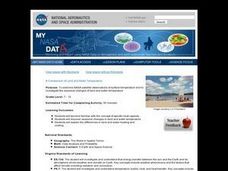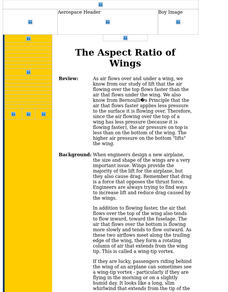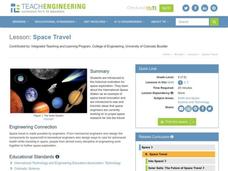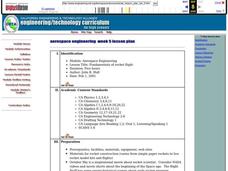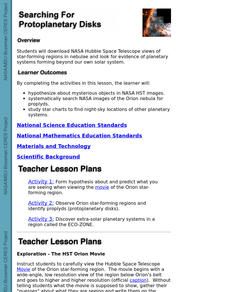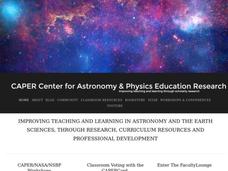Curated OER
What's the Frequency, Roy G. Biv?
Introduce starting space scientists to the electromagnetic spectrum, expecially the portion of visible light. Teach them about wavelength and frequesncy. Then give them a roll of adding machine tape and a manila folder to make a...
Curated OER
Time That Period
Physical science starters play with a pendulum in order to experience periodicity. Detailed procedures and a worksheet are included for day one. For day two, learners will use a graphing calculator to help them plot orbit data from a...
Curated OER
Seasons and Cloud Cover, Are They Related?
Students use NASA satellite data to see cloud cover over Africa. In this seasons instructional activity students access data and import it into Excel.
Curated OER
A Comparison of Land and Water Temperature
Students examine NASA satellite observations of surface temperature and investigate the seasonal changes of land and water temperature.
Curated OER
The Aspect Ratio of Wings
Junior engineers examine aspect ration in airplane wings. Using the length and width of two differetn wings, they calculate the aspect ratios and compare drag rankings. An engineering or space science class would benefit from this lesson...
Curated OER
Space Travel
Students study the International Space Station and space exploration. In this space travel lesson students describe the different types of engineers that contribute to space travel.
Curated OER
Asteroids
Young scholars study asteroids and how their size relates to a possible danger of one colliding with Earth. In this asteroids lesson students see how big an asteroid has to be to cause destruction to Earth.
Curated OER
Blazing Gas
Fourth graders read and discuss the sun and the energy we use on Earth from the sun. In this sun lesson plan, 4th graders discuss the solar system, planets, and answer short answer questions.
Curated OER
Aerospace Engineering
Twelfth graders examine the physics of rocket flight. They build and launch model rockets to measure their performances.
Curated OER
Tour of the Solar System
Learners engage in science, math, and language activities as they do research on the components of the solar system. The class begins with some anticipatory activities and discussions before it is divided into small groups to conduct...
Curated OER
Tropical Atlantic Aerosols
Students analyze NASA data from the Multi-angle Imaging Spectroradiometer. In this NASA data lesson, students access an assigned website to examine information from the MISR on the Terra Satellite. They determine how desert dust travels...
Curated OER
Searching For Protoplanetary Disks
High schoolers download NASA Hubble Space Telescope views of star-forming regions in nebulae and look for evidence of planetary systems forming beyond our own solar system. They hypothesize about mysterious objects in NASA HST images.
Curated OER
From Future Flight to Past Flight
Students complete a set of CD-ROM's to introduce them to the flight program at NASA. In groups, they research a topic related to flight and put their information on a CD-ROM. To end the lesson, they share their material with other...
Curated OER
Stellar Observations
Ninth graders study the uses of spectroscopy and the operation of the Hubble space telescope. In this astronomy lesson students complete a lab activity that includes graphing star color and temperature.
Curated OER
Ratios, Proportions, and Cross-multiplication
Students use cross-multiplication to find the unknown respiration rate of an astronaut. In this multiplication lesson plan, students also use the same process to find missing values in proportions.
Curated OER
Measuring Sizes
Students explore the concept of scale. In this measurement lesson, students measure common classroom objects in order to help them better understand scale.
Curated OER
How does the Earth compare to the other planets?
Students equate the size of the planets by determining their relative size. In this planet's size instructional activity, students use a variety of measurements to evaluate the sizes of the planets. Students share their comparisons and...
Curated OER
Private Sector Enticing Public into Final Frontier
Students study entrepreneurship in space. In this space science lesson, students discuss an article provided and explain why their senses are important to finding opportunities. Students list three possible opportunities in the...
Curated OER
The Expanding Universe
Students explore the expanding universe. In this science instructional activity, students use balloons to model the expansion of the universe. Students take measurements of the balloon expansion and answer questions directed...
Curated OER
Using Computer for Statistical Analysis
Students use the computer and S'COOL data for statistical analysis.
Curated OER
Detective Digis and the Computer Caper
Mathematicians participate in an hands-on activity to investigate the binary number system and write messages in binary code and have classmates decipher the messages. A said video on the topic does not seem to be available, but the...
Curated OER
Vectors
High schoolers listen to a lecture and complete a number of problems as they go. There are a variety of examples given and they are guided through the problem solving steps for each of the real-world scenarios regarding the purpose of...
Curated OER
Radiation Budget
Young scholars solve the mathematical word problems by looking at the Earth's Energy Budget Diagram. They will work in small groups and then develop their own unique math problems from the diagram and share with the class.
Curated OER
Sequencing From Close To Far
Students explore how objects stay the same size and only "look" like they change when closer are farther from the object. They sequence aerial photos and satellite images from closest to farthest.





